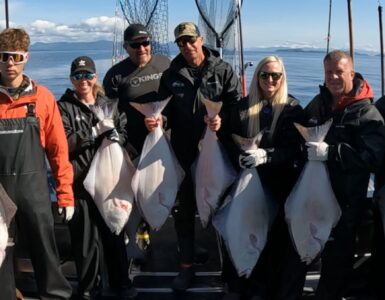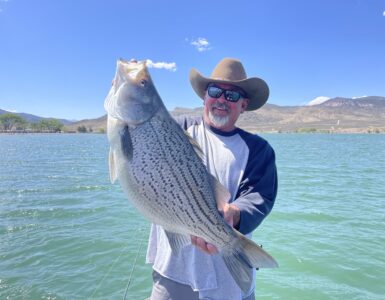<(Adam Intro) "Thanks for tuning into KSL Outdoors, I'm Adam Eakle. Utah's favorite tail-water fishery, that's the Green River below Flaming Gorge Dam is getting it's bi-annual checkup. The Division of Wildlife Resources, they are going fishing and they are using the most productive way possible, they're using a little electricity.">
<(Ryan) "who's done dye marks?">
In the waning light, below Flaming Gorge Dam, DWR biologists and volunteers have set up an outdoors laboratory. The goal, catch, tag and process nearly one thousand fish.
<(Ryan Mosley, DWR Flaming Gorge Project Leader) "We are doing our spring electro fishing on the green river. It's our first night of this survey we are doing a one mile stretch here below the dam. And then tomorrow night we'll be doing a one mile stretch below little hole.">
<(Ryan Mosley) "It's really important for us to monitor this fishery, it is a high use fishery. We are fortunate that it doesn't have a high harvest, but we can track trends through time and institute management changes as necessary, you know for instance this year we are going to be cutting our stocking quota some to. We just kind of feel like we are throwing fuel to the fire by stocking the green, so we are going to back off a little bit, see what these changes make over time. We also have long-term goals of adding cutthroat back to this fishery.">
<(Launch boat at nigh) "ok, you ready.">
To get a sizeable sample on this Blue Ribbon fishery, biologists fish at night. They do this for two reasons, one they avoid any conflicts with anglers and they catch more fish. This jet boat is equipped to stun the fish, just long enough for biologists to net them.
<(Ryan) "ready?">
<(Ryan) "The electro-fishing boat actually puts an electrical impulse into the water, it attracts the fish towards the boat and upon getting closer to the boat, they get into that electrical field it stuns those fish.">
<(Ryan) "Come on boys, get them.">
<(Charlie) "There you go." (scoops fish)>
<(Ryan) "Upon getting in the live-well on the boat, electrical field is off and they immediately start to revive.">
<(Ryan) "When we bring the fish back we are looking at what size the fish are, taking lengths and weights.">
<(Clint weight) "348.">
<(Ryan) "We're also looking at rainbow trout that are spray dyed each spring before they are stocked and we are looking at those rainbows under a UV light and tracking that size class through time, the success of that size class through time.">
<(biologist) "no tag found.">
<(Ryan) "Whether it's brown trout or rainbow trout, some of those fish may have a pit tag in them. That allows us to look at individual fish and track their growth and survival over time. It also allows us to generate a population estimate on an annual basis for trout in the green river.">
<(Ryan) "Over like the last decade we actually seen a declining trend in the size of trout in the green river. The average size of a brown trout in here now is about 15 inches where it used to be about 17 inches. There is a lot of different things that could be causing that. It could be density dependant reaction, as a result of so many trout in the Green River. You know we boast about 20,000 trout per mile. It could also be a result of the drought years.">
<(Charles Card, N.E. Coordinator for Trout Unlimited) "Hopefully with last years high water and the year before that of normal flows, hopefully we'll see a little increase in size.">
<(Ryan) "There has been a rapid response of bugs in the river this year, the invertebrates, the flush and flow that we had last year, you know Mother Nature gave us quite the flood event on the Green river and the invertebrates have responded really quickly. A lot of the anglers are talking about how the hatches have been so much more consistent and more abundant for midges, BWO. We've even heard people bragging up how the early stone flies have been really impressive this year, something that hasn't been seen in a lot years.">
<(Ryan) "Using electro-fishing as an assessment tool, allows us to track these changes over time and also rely that information through people like yourself and let people know what's out here, what they can expect and as you are seeing tonight there is a lot of quality fish out there and it should be an exceptional year of fishing on the Green River.">
<(Kevin Clegg, Flaming Gorge Resort) "we've had some good spring weather, things are looking good.">
<(Tag) biologists say the mortality rate on the fish with this operation is actually fairly low, once the fish are worked over, they are put back into these holding nets here to recover and then released back into the river. Coming up on KSL Outdoors, we try a little more traditional way of catching fish, we'll have that in just a moment, but first tonights quiz question.">







Add comment